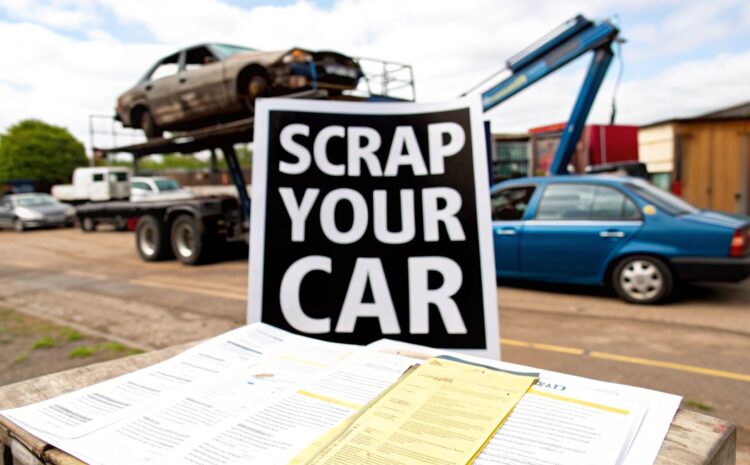
How to Scrap Your Car in Feltham: The Complete 2025 Guide
When it's time to say goodbye to your old car in Feltham, the process might seem a bit daunting. But it's actually a straightforward and regulated procedure, designed to make sure everything is handled correctly, from getting a fair price to completing the legal paperwork. The most important thing is working with a proper Authorised Treatment Facility (ATF). This guarantees you're following all the DVLA rules and that the whole process is above board.
Your Essential Guide to Scrapping a Car in Feltham
Let's face it, sometimes scrapping a car is the only sensible move. Maybe it's failed its MOT spectacularly, the repair bills are eye-watering, or it's just given up the ghost. For many in Feltham, the expansion of London's Ultra Low Emission Zone (ULEZ) was the final nudge they needed, making older, non-compliant cars too expensive to run.
Getting your car scrapped isn't just about having it towed away. It's a formal process that officially ends your responsibility for the vehicle, protecting you from any future fines or legal issues. This guide will walk you through exactly what to expect.
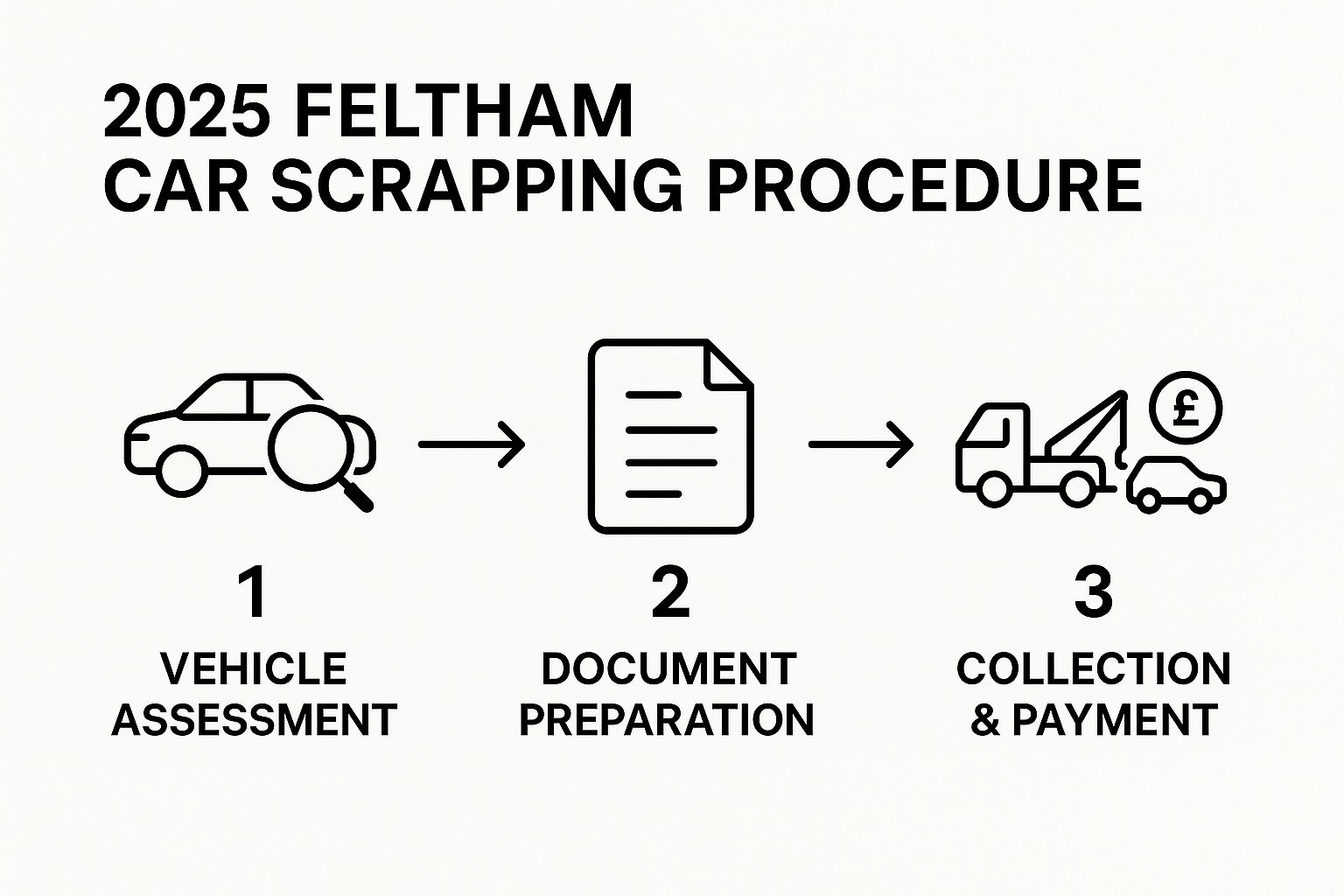
What the Scrapping Process Looks Like
From your initial decision to the final payment, the journey follows a few logical stages. It all kicks off with getting a quote for your car, which is typically based on its weight in scrap metal, though valuable parts can sometimes boost the price.
Once you’ve agreed on a price, you'll need to get your paperwork in order – your V5C logbook is the main document here. Then, it's just a matter of arranging a convenient, free collection time and getting paid. It’s worth noting that cash payments for scrap cars are illegal, so you'll receive the money by bank transfer.
To make things crystal clear, here’s a quick checklist of what you'll need at each stage.
Feltham Car Scrappage Checklist
| Stage | What You Need | Key Action |
|---|---|---|
| Valuation | Car registration, make, model | Get an instant online quote or call a local ATF. |
| Paperwork | V5C logbook (or alternative proof) | Find your V5C and have it ready for collection day. |
| Collection | Keys, any relevant documents | Agree on a pickup time and clear out personal items. |
| Disposal | Nothing further needed from you | Wait for the Certificate of Destruction (CoD) to arrive. |
This table neatly summarises your journey. The most critical part for your peace of mind is that final step: receiving the CoD.
Key Takeaway: Your Certificate of Destruction (CoD) is everything. This is the official DVLA-linked document from the ATF that legally proves your car has been scrapped and you're no longer the registered keeper. Don't consider the job done until you have it.
The ULEZ Factor and Available Support
The ULEZ expansion across all of London has been a game-changer for many drivers in Feltham. To help ease the transition to cleaner vehicles, a massive £210 million fund was set up for London's scrappage scheme to support eligible residents. Exploring our local services in Feltham can give you a clear idea of your options. This huge investment shows just how serious the push for cleaner air in the capital is.
How to Get the Best Scrap Value for Your Car
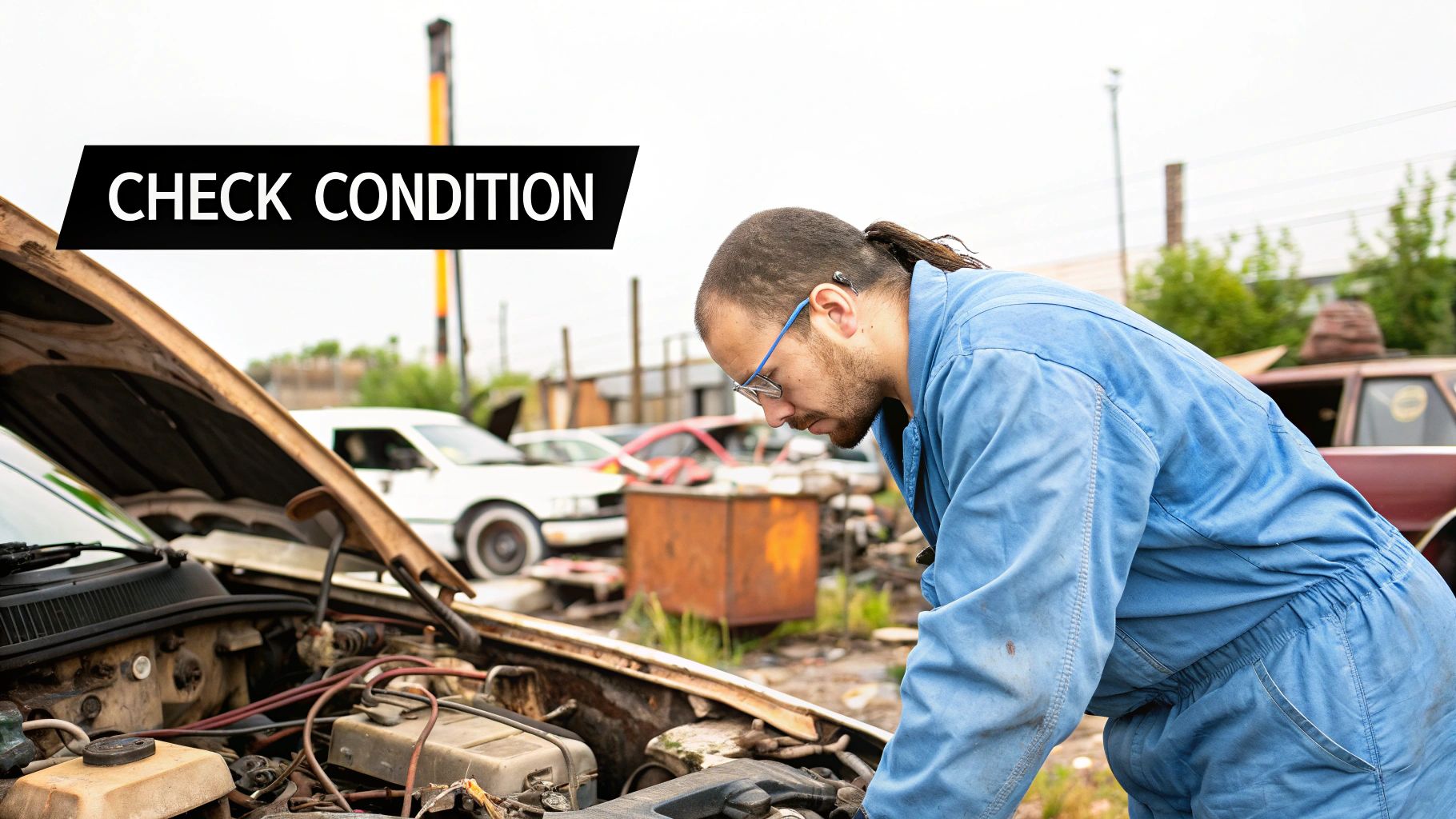
When it's time to part with your old car, you obviously want the best possible price. Getting the top scrap value in Feltham isn’t about luck; it’s about understanding what actually determines your car's worth in the eyes of a scrap yard.
The biggest factor, by a long shot, is weight. At its core, a scrap car is a commodity, and its value is tied to the global price of metal. A heavier car, like a big 4×4 or a van, has more raw metal, so it will naturally command a higher price than a small city car.
But it’s not just about tonnage. The make and model also have a role to play. Some vehicles have specific parts that are in demand, even from a non-runner. Things like catalytic converters (which contain precious metals), certain engine blocks, or even alloy wheels can be salvaged and resold, adding a little extra to your final payment.
Finding a Fair and Transparent Price
My best piece of advice? Never take the first offer you get. The scrap market is competitive, so it pays to shop around. Get quotes from a few different Authorised Treatment Facilities (ATFs) in the Feltham area to get a feel for the going rate. This simple step helps you instantly weed out any lowball offers.
When you're getting these quotes, be on the lookout for hidden fees. A trustworthy scrap service should always include free collection. Make sure you ask directly: "Is the price you're quoting the exact amount I'll receive?" There should be no surprise deductions for collection or paperwork.
Expert Tip: Scrap metal prices are influenced by global markets, a bit like oil or gold. While waiting for a price spike might get you a few extra quid, the fluctuations are usually minor for a single car. If you’re not in a desperate hurry, it might be worth keeping an eye on it, but don’t expect a massive difference.
If you want a more precise estimate based on your vehicle's details, it's worth checking out this guide on how much scrappage value your car might have.
Ultimately, securing the best deal comes down to two things: your car's physical specs and your own legwork in getting multiple, clear quotes. A little bit of knowledge puts you in a much stronger position to get a price that fairly reflects what your old car is truly worth.
Getting the Paperwork Right: Your DVLA Responsibilities
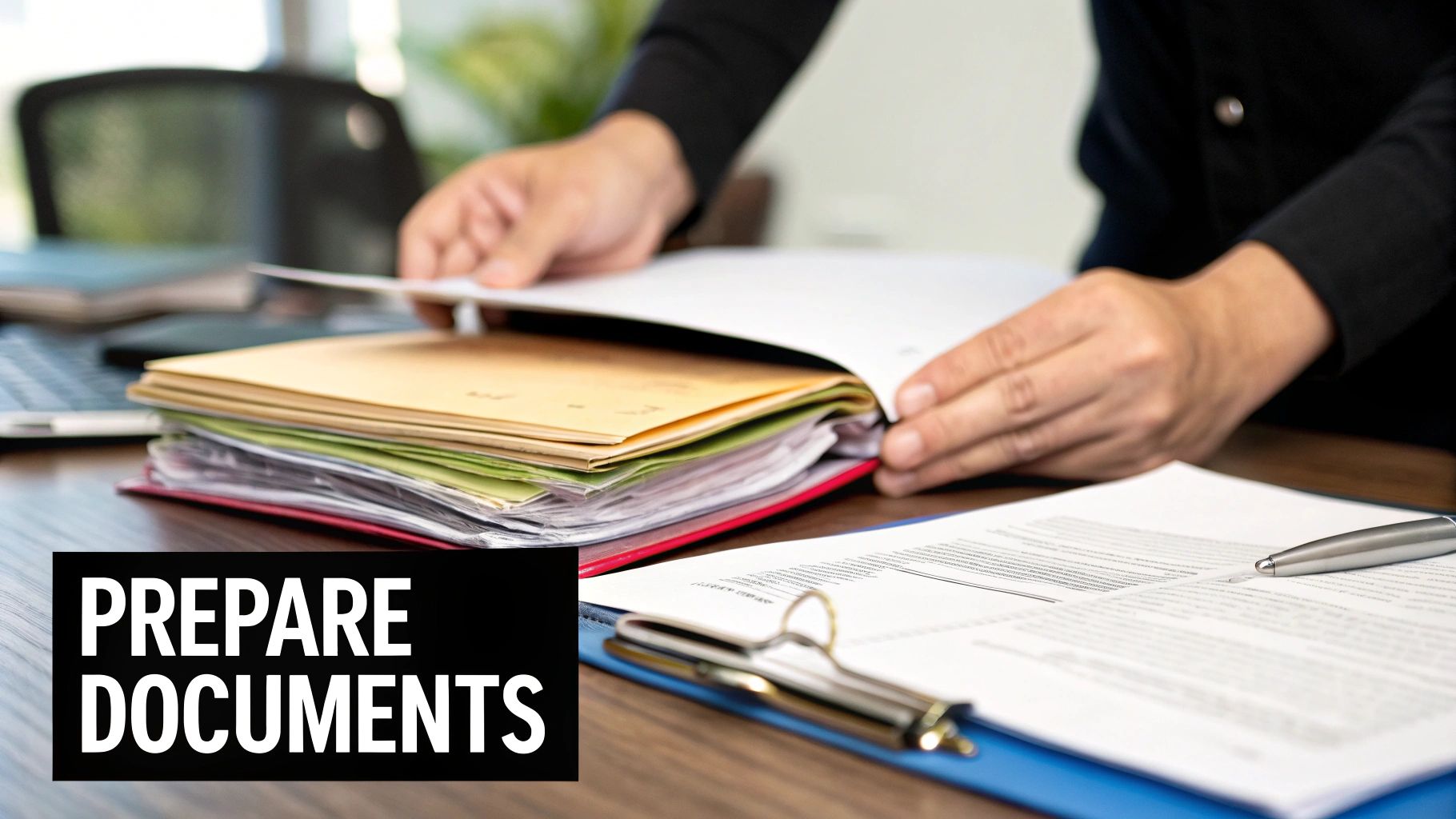
Let's be honest, dealing with paperwork is nobody's favourite job. But when it comes to scrapping your car, getting it right isn't just a box-ticking exercise—it's your legal shield. This is the part of the process that officially ends your responsibility for the vehicle, protecting you from any future hassle over tax, MOT, or insurance.
The key document you'll need is your V5C logbook, also known as the vehicle registration document. Have this ready for when the collection driver arrives.
How to Fill Out Your V5C Logbook
When the driver from the Authorised Treatment Facility (ATF) comes to collect your car, you'll need to fill out a specific part of the V5C together.
- On newer logbooks (issued after April 2019), you’ll be looking for Section 4. This is clearly marked for selling or transferring to a motor trader, insurer, or dismantler.
- If you have an older V5C, you'll need to complete Section 9 instead.
Both you and the collection agent will sign the relevant slip. They will take this section with them, but your job isn't quite done yet. You must tell the DVLA immediately that you've sold the vehicle to the trade. The fastest way to do this is online, but you can also send the main body of your V5C to the DVLA by post if you prefer.
What If I Can't Find My V5C?
It happens. If you've misplaced your logbook, you can still scrap your car in Feltham. You'll just need to send a letter to the DVLA yourself. Make sure it includes your name and address, the car's registration number, the exact date of the sale, and the full details (name and address) of the ATF that collected it.
Once the car has been collected, remember to cancel your insurance policy and claim a refund for any full months of unused road tax. If your car was off the road for a while before collection, you might also want to read our guide on how to SORN a vehicle for more details.
Your Ultimate Proof: The Certificate of Destruction (CoD)
If there's one document you absolutely must get, it's the Certificate of Destruction (CoD). This is the official, legally recognised proof that your vehicle has been properly scrapped and is permanently off the road.
By law, the ATF must issue a CoD within seven days of taking your car. This certificate is sent to you and, crucially, is logged directly with the DVLA. This action is what officially removes you as the registered keeper from their database.
Without a CoD, you have no legal proof of disposal. It’s essential that you only ever use a scrap service that guarantees you'll receive one.
What to Expect on Car Collection Day
The big day has arrived, and a little bit of prep work will make sure everything goes off without a hitch. Your first job is to give the car one last, thorough clear-out. You’d be surprised what gets left behind, so have a good rummage through the glove compartment, under the seats, and in the boot for any forgotten odds and ends.
When the collection team shows up at the scheduled time, they’ll give the car a quick once-over. They’re not there to kick the tyres and haggle; they just need to confirm it’s the vehicle they were expecting and that major components like the engine and wheels haven't gone missing. Don't stress about its condition – they're fully prepared for a non-runner.
Getting Paid and Signing it Over
Now for the important part: the payment. It's vital to understand that you won't be handed a wad of cash. Thanks to the Scrap Metal Dealers Act 2013, it's illegal for any scrap merchant to pay for a vehicle with physical money. This law was put in place to stamp out metal theft by making every transaction traceable.
Key Takeaway: Payment is always made by a secure bank transfer or a business cheque. The driver will usually sort out the bank transfer right there and then, showing you the confirmation on their device before they even think about loading up your car.
This system is designed to protect everyone involved. Once you've seen the money has been sent, you'll finish the legal side of things by signing over the V5C logbook.
It's worth remembering that getting older, more polluting cars off the road is a positive step. Past government initiatives have shown real benefits; the 2009-2010 UK scrappage scheme, for instance, supported an estimated 100,000 UK jobs and spurred the sale of over 181,000 cleaner vehicles. If you're curious, you can read more about the impact of national scrappage schemes on the SMMT website.
With the payment confirmed and the paperwork signed, the driver will professionally load your car onto their recovery truck. From your side, the job is done. All that's left is to keep an eye out for your official Certificate of Destruction to arrive in the post.
Common Scrapping Mistakes and How to Avoid Them
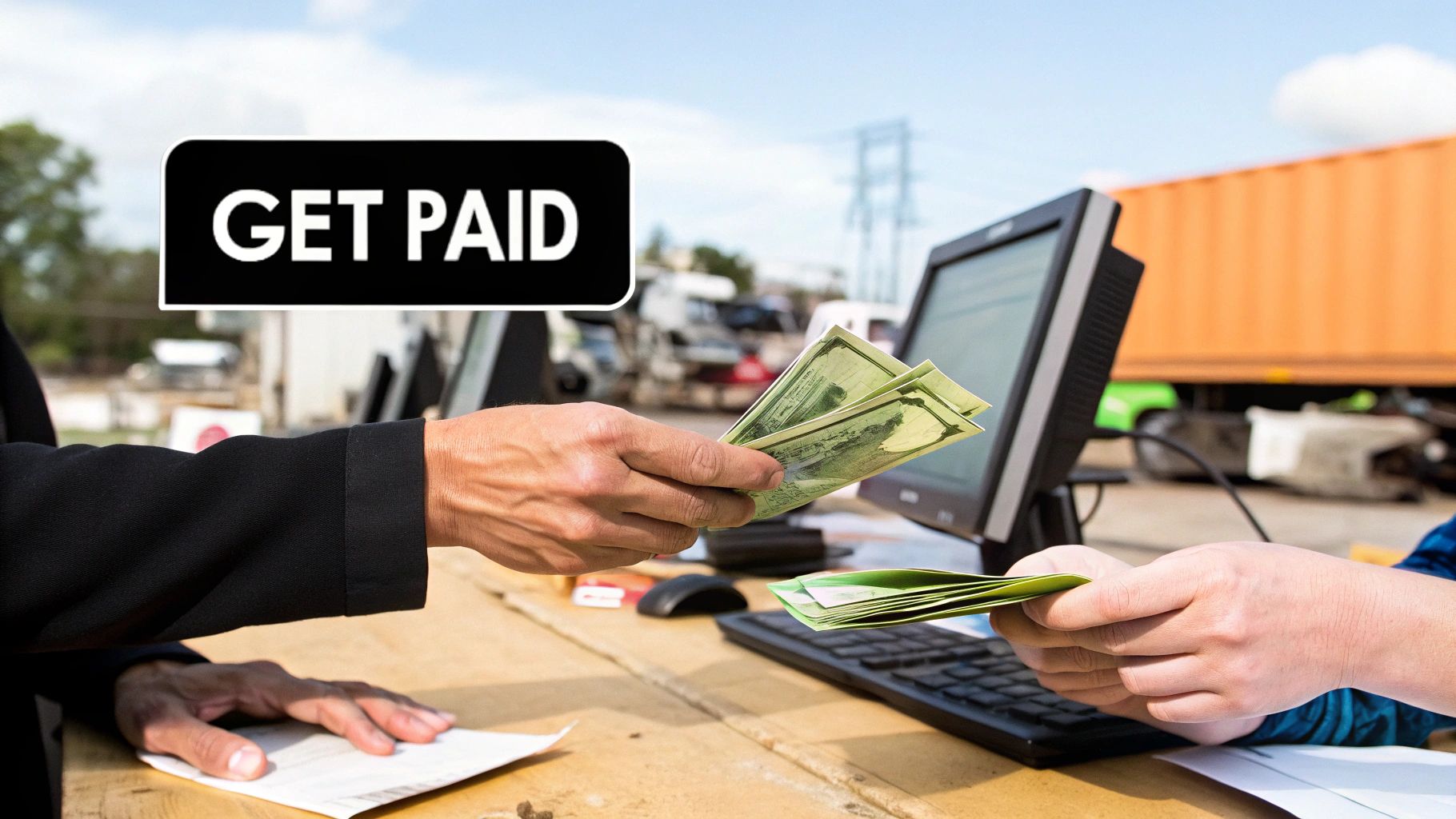
When it's time to scrap your car, a little know-how can save you a world of headaches. Being aware of the common pitfalls from the start is the best way to make sure your vehicle is handled safely, legally, and without any nasty surprises showing up later on.
One of the most frequent slip-ups I see is people choosing the wrong service. It’s tempting to jump at a high quote from a "man with a van," but if they aren't a registered Authorised Treatment Facility (ATF), you're rolling the dice. These unlicensed operators often cut legal corners, which can leave you on the hook if the car is misused.
Another massive red flag is any talk of cash payments. The Scrap Metal Dealers Act of 2013 made paying cash for scrap cars illegal. So, insisting on a traceable bank transfer isn't just a good idea; it's a legal safeguard that protects you.
Don't Get Caught Out
Getting the process wrong can lead to some serious financial and legal trouble. To help you steer clear of any issues, here are the most critical things to avoid.
- Accepting Cash Payments: Never, ever agree to a cash-in-hand deal. A legitimate ATF will always pay by bank transfer or cheque, giving you a clear, official record of the transaction.
- Forgetting to Notify the DVLA: This is an easy one to forget in the moment. After signing over the V5C logbook, you absolutely must tell the DVLA you're no longer the keeper. If you don't, you could be hit with automatic fines months down the line.
- Skipping the Certificate of Destruction: This document is your only official proof that the car has been legally taken off the road for good. Don't consider the job done until you have this certificate.
A Real-World Scenario: Picture this: you get a parking fine in the post for a car you thought you scrapped six months ago. This is exactly what happens when an unlicensed operator sells the car on instead of destroying it, still registered in your name. Without that Certificate of Destruction, proving you did everything right is nearly impossible.
It's interesting to see how regulations directly impact scrap rates. For instance, when Scotland introduced its new Low Emission Zones, there was a 64% year-on-year surge in scrappage demand. We saw a similar pattern with London's ULEZ expansion. You can read more about how emissions rules influence scrapping decisions on ScrapCarComparison.co.uk.
By keeping these common mistakes in mind, you can navigate the process of how to scrap your car in Feltham with complete confidence.
Your Feltham Car Scrapping Questions Answered
Even when you know the steps, a few questions always pop up. It's completely normal. We get calls all the time from people in Feltham needing a bit more clarity, so we’ve put together answers to the most common queries we hear.
What if I Can't Find My V5C Logbook?
Don't panic – it happens more often than you'd think. While having your V5C registration document certainly streamlines things, a missing one isn't a showstopper. Any legitimate Authorised Treatment Facility (ATF) can still proceed, but they'll need to verify you're the rightful owner in another way.
You'll have to show them your photo ID (like a driving licence or passport) and a recent utility bill or bank statement as proof of address.
Once the car is gone, the responsibility falls on you to inform the DVLA. You'll need to send them a letter containing:
- Your full name and address
- The car's registration number (the "number plate")
- The exact date you handed the car over
- The full name and address of the scrap yard (the ATF) that took it
How Long Until I Receive My Certificate of Destruction?
This is a really important one. The ATF is legally obligated to issue your Certificate of Destruction (CoD) within seven days of scrapping your vehicle. In most cases, they'll email it over to you for speed, but some still send a copy in the post.
A Quick Tip from Experience: If a week has passed and you still haven't seen that certificate, get on the phone to the ATF right away. The CoD is the only official document that proves the car is no longer your legal responsibility. Don't let it slide.
Other Things People Often Ask
Can I scrap a car that isn't in my name?
Straightforward answer: no. To scrap a car legally, you have to be the registered keeper. The name on your photo ID needs to match what’s on the V5C. If you’re helping out a relative, for example, you’ll need a signed letter of permission from them, along with their ID.
How does the ULEZ scrappage scheme work with this?
This is where things can get interesting. The basic scrap value is just based on the car's weight. However, if your car qualifies for the TfL ULEZ scrappage scheme, you could receive a grant that is significantly more than the metal value. The key is that you must apply for the scheme and get official approval before you let the car go.
Ready to get a fast, fair, and reliable quote for your vehicle? Fast Scrap Car offers free, same-day collection across Feltham and guarantees a hassle-free process from start to finish. Get your instant quote today at https://fastscrapcar.co.uk.
